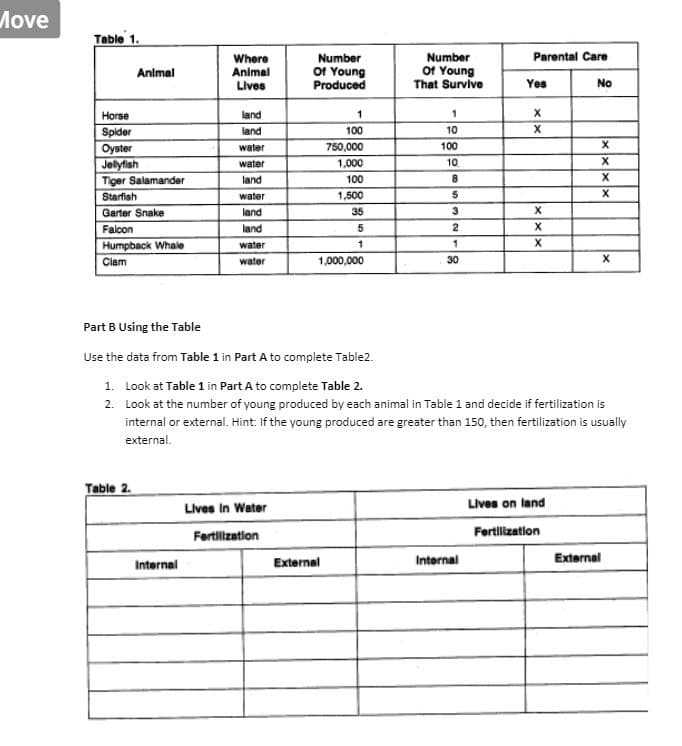Part B Using the Table Use the data from Table 1 in Part A to complete Table2. 1. Look at Table 1 in Part A to complete Table 2. 2. Look at the number of young produced by each animal in Table 1 and decide if fertilization is internal or external. Hint: If the young produced are greater than 150, then fertilization is usually external.
Part B Using the Table Use the data from Table 1 in Part A to complete Table2. 1. Look at Table 1 in Part A to complete Table 2. 2. Look at the number of young produced by each animal in Table 1 and decide if fertilization is internal or external. Hint: If the young produced are greater than 150, then fertilization is usually external.
Biology: The Unity and Diversity of Life (MindTap Course List)
15th Edition
ISBN:9781337408332
Author:Cecie Starr, Ralph Taggart, Christine Evers, Lisa Starr
Publisher:Cecie Starr, Ralph Taggart, Christine Evers, Lisa Starr
Chapter44: Population Ecology
Section: Chapter Questions
Problem 8SQ
Related questions
Question
100%

Transcribed Image Text:Лove
Table 1.
Parental Care
Where
Animal
Number
Of Young
Produced
Number
Of Young
That Survive
Anlmal
Lives
Yes
No
land
1
Horse
Spider
Oyster
Jelyfish
Tiger Salamander
land
100
10
water
750,000
100
water
1,000
10
land
100
5.
Starfish
Garter Snake
Falcon
Humpback Whale
Clam
water
1,500
land
35
3
land
5
2
water
1
1
water
1,000,000
30
Part B Using the Table
Use the data from Table 1 in Part A to complete Table2.
1. Look at Table 1 in Part A to complete Table 2.
2. Look at the number of young produced by each animal in Table 1 and decide if fertilization is
internal or external. Hint: If the young produced are greater than 150, then fertilization is usually
external.
Table 2.
Lives in Water
Lives on land
Fertilization
Fertilization
External
Internal
External
Internal
Expert Solution
This question has been solved!
Explore an expertly crafted, step-by-step solution for a thorough understanding of key concepts.
This is a popular solution!
Trending now
This is a popular solution!
Step by step
Solved in 2 steps with 1 images

Knowledge Booster
Learn more about
Need a deep-dive on the concept behind this application? Look no further. Learn more about this topic, biology and related others by exploring similar questions and additional content below.Recommended textbooks for you

Biology: The Unity and Diversity of Life (MindTap…
Biology
ISBN:
9781337408332
Author:
Cecie Starr, Ralph Taggart, Christine Evers, Lisa Starr
Publisher:
Cengage Learning

Biology 2e
Biology
ISBN:
9781947172517
Author:
Matthew Douglas, Jung Choi, Mary Ann Clark
Publisher:
OpenStax

Biology: The Unity and Diversity of Life (MindTap…
Biology
ISBN:
9781305073951
Author:
Cecie Starr, Ralph Taggart, Christine Evers, Lisa Starr
Publisher:
Cengage Learning

Biology: The Unity and Diversity of Life (MindTap…
Biology
ISBN:
9781337408332
Author:
Cecie Starr, Ralph Taggart, Christine Evers, Lisa Starr
Publisher:
Cengage Learning

Biology 2e
Biology
ISBN:
9781947172517
Author:
Matthew Douglas, Jung Choi, Mary Ann Clark
Publisher:
OpenStax

Biology: The Unity and Diversity of Life (MindTap…
Biology
ISBN:
9781305073951
Author:
Cecie Starr, Ralph Taggart, Christine Evers, Lisa Starr
Publisher:
Cengage Learning

Biology (MindTap Course List)
Biology
ISBN:
9781337392938
Author:
Eldra Solomon, Charles Martin, Diana W. Martin, Linda R. Berg
Publisher:
Cengage Learning